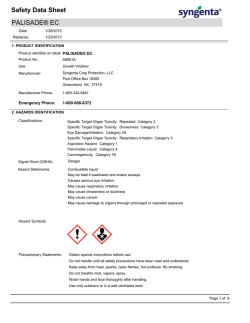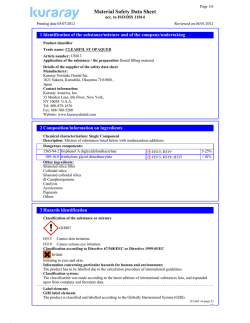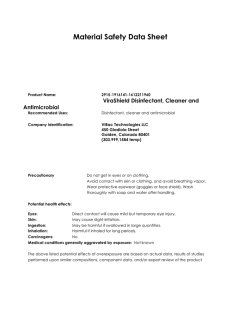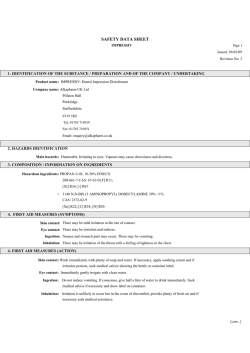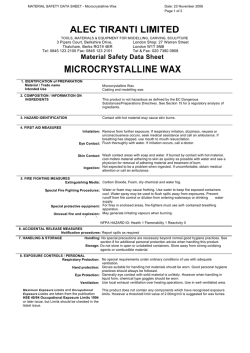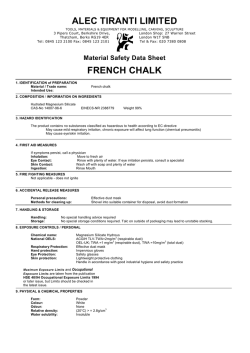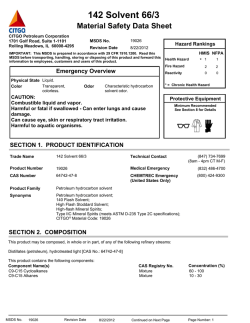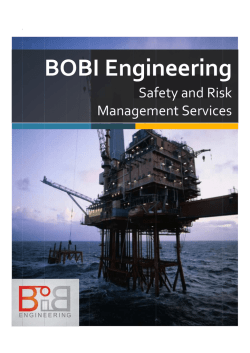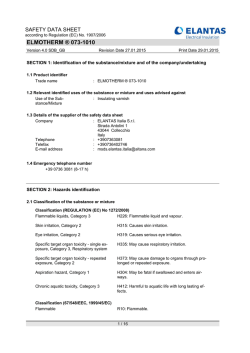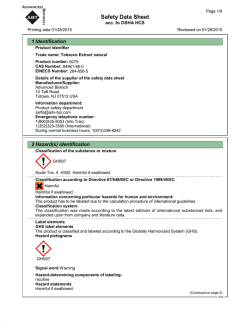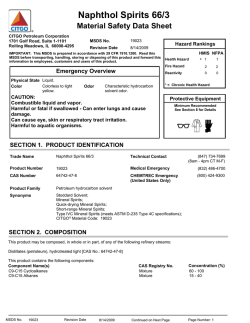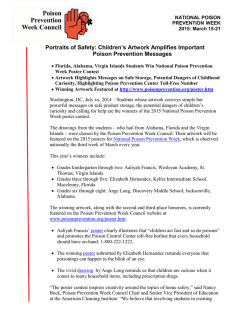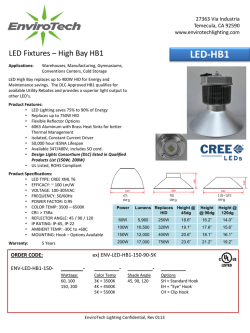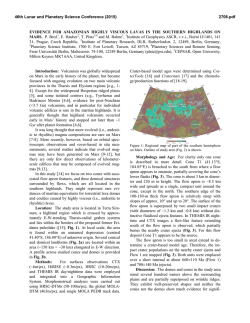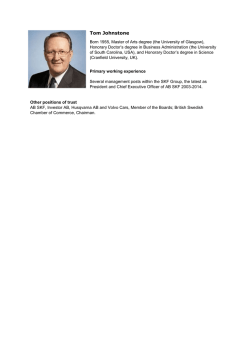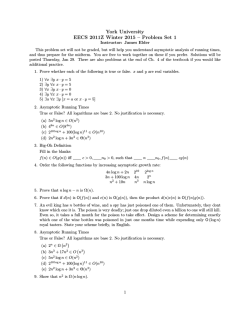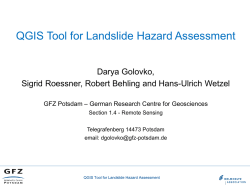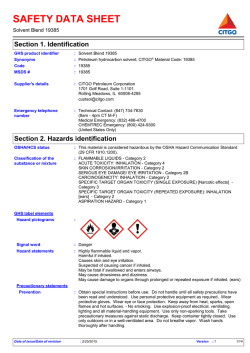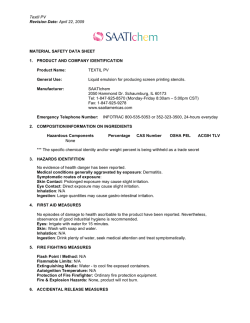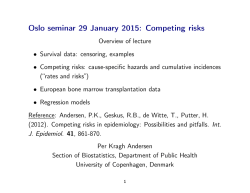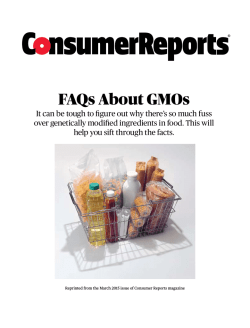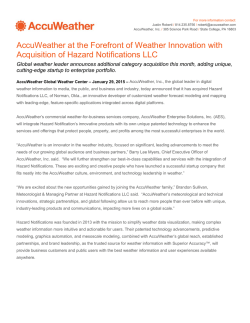
Safety Data Sheet APRON XL - Crop Data Management Systems, Inc.
Safety Data Sheet APRON XL® Date: 1/28/2015 Replaces: 1/9/2015 1. PRODUCT IDENTIFICATION Product identifier on label: APRON XL® Product No.: A9382A Use: Fungicide Manufacturer: Syngenta Crop Protection, LLC Post Office Box 18300 Greensboro NC 27419 Manufacturer Phone: 1-800-334-9481 Emergency Phone: 1-800-888-8372 2. HAZARDS IDENTIFICATION Classifications: Oral: Category 4 Eye Damage/Irritation: Category 2A Signal Word (OSHA): Warning Hazard Statements: Harmful if swallowed Causes serious eye irritation Hazard Symbols: Precautionary Statements: Wash hands and face thoroughly after handling. Do not eat, drink or smoke when using this product. Wear eye protection. If in eyes: Rinse cautiously with water for several minutes. Remove contact lenses, if present and easy to do. Continue rinsing. If eye irritation persists: Get medical advice. If swallowed: Call a poison center, doctor or Syngenta if you feel unwell. Rinse mouth. Dispose of contents and container in accordance with local regulations. Other Hazard Statements: None Page 1 of 7 Safety Data Sheet APRON XL® Date: 1/28/2015 Replaces: 1/9/2015 3. COMPOSITION/INFORMATION ON INGREDIENTS Chemical Name Common Name CAS Number Concentration Other ingredients Other ingredients Trade Secret 66.7% (R,S)-2-[(2,6-dimethylphenyl)methoxyacetylamino]-propionic acid methyl ester Mefenoxam 70630-17-0 & 69516-34-3 33.3% Ingredients not precisely identified are proprietary or non-hazardous. Values are not product specifications. 4. FIRST AID MEASURES Have the product container, label or Safety Data Sheet with you when calling Syngenta (800-888-8372), a poison contol center or doctor, or going for treatment. Ingestion: If swallowed: Call Syngenta (800-888-8372), a poison control center or doctor immediately for treatment advice. Do not give any liquid to the person. Do not induce vomiting unless told to do so after calling 800-8888372 or by a poison control center or doctor. Do not give anything by mouth to an unconscious person. Eye Contact: If in eyes: Hold eye open and rinse slowly and gently with water for 15-20 minutes. Remove contact lenses, if present, after 5 minutes, then continue rinsing eye. Call Syngenta (800-888-8372), a poison control center or doctor for treatment advice. Skin Contact: If on skin or clothing: Take off contaminated clothing. Rinse skin immediately with plenty of water for 15-20 minutes. Call Syngenta (800-888-8372), a poison control center or doctor for treatment advice. Inhalation: If inhaled: Move person to fresh air. If person is not breathing, call 911 or an ambulance, then give artificial respiration, preferably mouth-to-mouth if possible. Call Syngenta (800-888-8372), a poison control center or doctor for further treatment advice. Most important symptoms/effects: Eye irritation Indication of immediate medical attention and special treatment needed: There is no specific antidote if this product is ingested. Treat symptomatically. 5. FIRE FIGHTING MEASURES Suitable (and unsuitable) extinguishing media: Use dry chemical, foam or CO2 extinguishing media. If water is used to fight fire, dike and collect runoff. Specific Hazards: During a fire, irritating and possibly toxic gases may be generated by thermal decomposition or combustion. Special protective equipment and precautions for firefighters: Wear full protective clothing and self-contained breathing apparatus. Evacuate nonessential personnel from the area to prevent human exposure to fire, smoke, fumes or products of combustion. 6. ACCIDENTAL RELEASE MEASURES Personal precautions, protective equipment, and emergency procedures: Follow exposure controls/personal protection outlined in Section 8. Methods and materials for containment and cleaning up: Control the spill at its source. Contain the spill to prevent from spreading or contaminating soil or from entering sewage and Page 2 of 7 Safety Data Sheet APRON XL® Date: 1/28/2015 Replaces: 1/9/2015 drainage systems or any body of water. Clean up spills immediately, observing precautions outlined in Section 8. Cover entire spill with absorbing material and place into compatible disposal container. Scrub area with hard water detergent (e.g. commercial products such as Tide, Joy, Spic and Span). Pick up wash liquid with additional absorbent and place into compatible disposal container. Once all material is cleaned up and placed in a disposal container, seal container and arrange for disposition. 7. HANDLING AND STORAGE Precautions for safe handling: Store the material in a well-ventilated, secure area out of reach of children and domestic animals. Do not store food, beverages or tobacco products in the storage area. Prevent eating, drinking, tobacco use, and cosmetic application in areas where there is a potential for exposure to the material. Wash thoroughly with soap and water after handling. Conditions for safe storage, including any incompatibilities: Not Applicable 8. EXPOSURE CONTROLS/PERSONAL PROTECTION THE FOLLOWING RECOMMENDATIONS FOR EXPOSURE CONTROLS/PERSONAL PROTECTION ARE INTENDED FOR THE MANUFACTURE, FORMULATION AND PACKAGING OF THIS PRODUCT. FOR COMMERCIAL APPLICATIONS AND/OR ON-FARM APPLICATIONS CONSULT THE PRODUCT LABEL. Occupational Exposure Limits: Chemical Name OSHA PEL ACGIH TLV Other Source Other ingredients Not Applicable Not Applicable Not Applicable Not Applicable Mefenoxam Not Established Not Established 10 mg/m³ TWA Syngenta Appropriate engineering controls: Use effective engineering controls to comply with occupational exposure limits (if applicable). Individual protection measures: Ingestion: Prevent eating, drinking, tobacco usage and cosmetic application in areas where there is a potential for exposure to the material. Wash thoroughly with soap and water after handling. Eye Contact: Where eye contact is likely, use chemical splash goggles. Facilities storing or utilizing this material should be equipped with an eyewash facility and a safety shower. Skin Contact: Where contact is likely, wear chemical-resistant gloves (such as barrier laminate, butyl rubber, nitrile rubber, neoprene rubber, natural rubber, polyethylene, polyvinyl chloride [PVC] or Viton), coveralls, socks and chemical-resistant footwear. Inhalation: A respirator is not normally required when handling this substance. Use effective engineering controls to comply with occupational exposure limits. In case of emergency spills, use a NIOSH approved respirator with any N, R, P or HE filter. Page 3 of 7 Safety Data Sheet APRON XL® Date: 1/28/2015 Replaces: 1/9/2015 9. PHYSICAL AND CHEMICAL PROPERTIES Appearance: Amber liquid Odor: Light oily/petroleum Odor Threshold: Not Available pH: 5 - 7 (1% suspension in water) Melting point/freezing point: Not Applicable Initial boiling point and boiling range: Not Available Flash Point (Test Method): > 200°F Flammable Limits (% in Air): Flammability: Not Applicable Vapor Pressure: Mefenoxam 2.5 x 10(-5) mmHg @ 77°F (25°C) Vapor Density: Not Available Relative Density: 1.114 g/cm³ ; 9.29 lbs/gal @ 68°F (20°C) Solubility (ies): Mefenoxam 26 g/l @ 77°F (25°C) Partition coefficient: n-octanol/water: Autoignition Temperature: Not Available Decomposition Temperature: Not Available Viscosity: Not Available Other: 10. STABILITY AND REACTIVITY Reactivity: Not reactive. Chemical stability: Stable under normal use and storage conditions. Possibility of hazardous reactions: Conditions to Avoid: Will not occur. None known. Incompatible materials: None known. Hazardous Decomposition Products: None known. 11. TOXICOLOGICAL INFORMATION Health effects information Likely routes of exposure: Symptoms of exposure: Dermal, Inhalation Eye irritation Delayed, immediate and chronic effects of exposure: Eye irritation Numerical measures of toxicity (acute toxicity/irritation studies (finished product)) Ingestion: Oral (LD50 Rat) : 862 mg/kg body weight Page 4 of 7 Safety Data Sheet APRON XL® Date: 1/28/2015 Replaces: 1/9/2015 Dermal: Dermal (LD50 Rabbit) : > 2020 mg/kg body weight Inhalation: Inhalation (LC50 Rat) : > 6.9 mg/l air - 4 hours Eye Contact: Moderately Irritating (Rabbit) Skin Contact: Slightly Irritating (Rabbit) Skin Sensitization: Not a Sensitizer (Guinea Pig) Reproductive/Developmental Effects Mefenoxam: None observed. Chronic/Subchronic Toxicity Studies Mefenoxam: Liver effects at high dose animal tests. Carcinogenicity Mefenoxam: None observed. Chemical Name NTP/IARC/OSHA Carcinogen Other ingredients No (R,S)-2-[(2,6-dimethylphenyl)methoxyacetylamino]-propionic acid methyl ester No Other Toxicity Information None Toxicity of Other Components Other ingredients Not Applicable Target Organs Active Ingredients Mefenoxam: Inert Ingredients Other ingredients: Liver Not Applicable 12. ECOLOGICAL INFORMATION Eco-Acute Toxicity Mefenoxam: Fish (Rainbow Trout) 96-hour LC50 > 121 ppm Invertebrate (Water Flea) Daphnia Magna 48-hour EC50 > 113 ppm Bird (Bobwhite Quail) 14-day LD50 981 mg/kg Environmental Fate Mefenoxam: Page 5 of 7 Safety Data Sheet APRON XL® Date: 1/28/2015 Replaces: 1/9/2015 The information presented here is for the active ingredient, mefenoxam. Does not bioaccumulate. Not persistent in soil or water. Moderate mobility in soil. Mixes/sinks (after 24 h). 13. DISPOSAL CONSIDERATIONS Disposal: Do not reuse product containers. Dispose of product containers, waste containers, and residues according to local, state, and federal health and environmental regulations. Characteristic Waste: Not Applicable Listed Waste: Not Applicable 14. TRANSPORT INFORMATION DOT Classification Ground Transport - NAFTA Not regulated Comments Water Transport - International Proper Shipping Name: Environmentally Hazardous Substance, Liquid, N.O.S. (Fatty Ammonium Ether Sulfate), Marine Pollutant Hazard Class: Class 9 Identification Number: UN 3082 Packing Group: PG III Air Transport Proper Shipping Name: Environmentally Hazardous Substance, Liquid, N.O.S. (Fatty Ammonium Ether Sulfate) Hazard Class: Class 9 Identification Number: UN 3082 Packing Group: PG III 15. REGULATORY INFORMATION Pesticide Registration: This chemical is a pesticide product registered by the Environmental Protection Agency and is subject to certain labeling requirements under federal pesticide law. These requirements differ from the classification criteria and hazard information required for safety data sheets, and for workplace labels of non-pesticide chemicals. Following is the hazard information as required on the pesticide label: Warning: Causes substantial but temporary eye irritation. Harmful if swallowed or absorbed through skin. Avoid contact with skin, eyes or clothing. EPA Registration Number(s): 100-799 EPCRA SARA Title III Classification: Section 311/312 Hazard Classes: Acute Health Hazard Section 313 Toxic Chemicals: None CERCLA/SARA 304 Reportable Quantity (RQ): Page 6 of 7 Safety Data Sheet APRON XL® Date: 1/28/2015 Replaces: 1/9/2015 None RCRA Hazardous Waste Classification (40 CFR 261): Not Applicable TSCA Status: Exempt from TSCA, subject to FIFRA 16. OTHER INFORMATION HMIS Hazard Ratings NFPA Hazard Ratings Health: Flammability: Instability: 2 1 0 Health: Flammability: Reactivity: 1 1 0 Syngenta Hazard Category: B,S 0 1 2 3 4 * Minimal Slight Moderate Serious Extreme Chronic For non-emergency questions about this product call: 1-800-334-9481 Original Issued Date: Revision Date: Section(s) Revised: 9/7/2004 1/28/2015 Replaces: 1/9/2015 4 The information and recommendations contained herein are based upon data believed to be correct. However, no guarantee or warranty of any kind, expressed or implied, is made with respect to the information contained herein. Page 7 of 7
© Copyright 2026
